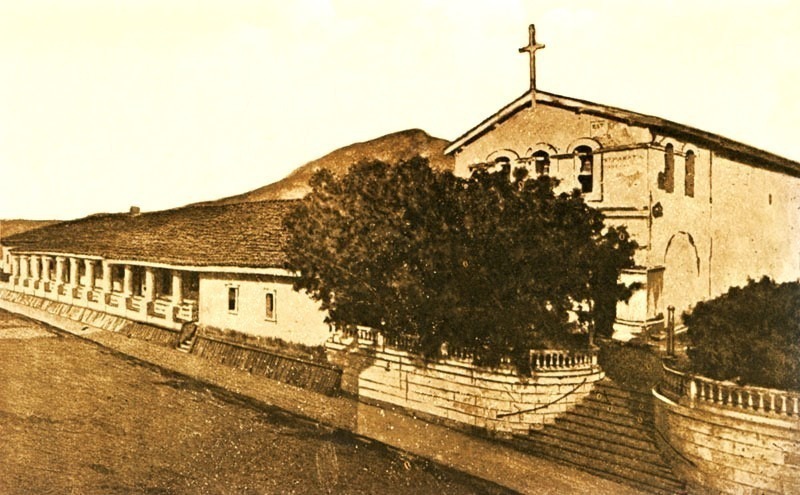Mission San Luis Obispo de Tolosa was founded on September 1, 1772, by Father Junípero Serra on a site halfway between Santa Barbara and Monterey. Father Serra erected a cross near San Luis Obispo Creek and celebrated the first mass.
The mission was named after Saint Louis of Anjou, the Bishop of Toulouse, and was fifth in the California Mission Chain. The Mission church is unusual in its design having two naves of approximately equal size. The secondary nave of the church is to the right of the altar, thus making this the only “L”-shaped mission church among all California Missions.
The mission site was discovered in 1769 by Gaspar de Portolà during his first expedition to Monterey Bay and nicknamed, according to Father Juan Crespí, the expedition diarist, the “Cañada de los Osos” in English the “Valley of the Bears“. The place went forgotten until food supplies started dwindling, and Father Serra sent a hunting expedition to kill the bears to feed the Spaniards and the Indian Converts.
The hunting expedition was so successful that Father Serra was convinced to build a new mission in the valley. Furthermore, the soil was fertile and the nearby local Indians, the Chumash tribe, were friendly and helpful. The day after the foundation of the San Luis Obispo Mission, Father Serra returned to San Diego. Father Jose Cavaller was put in charge of the building. He began the construction with the help of only five Spanish soldiers and two recently converted Indian neophytes.
The Chumash Indians started to help the Spaniards in the construction, erecting palisades and wooden structures as temporary shelters. However, the wooden buildings were set ablaze by other Indian tribes who lived further south and were determined to free the area from the new settlers. These hostile Indian tribes set the structures on fire three times before Father Cavaller started rebuilding using tiles and adobe.
The missionaries also developed red roofing tiles, similar to what they remembered from Europe, which all the missions quickly copied. Besides protecting the missions from fire raids, the tile roof kept building interiors shielded from rain.
Extensive building works, whose structures are still visible today, were begun in 1794. In 1819, the quadrangle was completed, and a year later, a vestibule was added. The arrival of two mission bells from Lima, Peru, followed soon after. The year 1820 also marked the end of improvements made to Mission San Luis Obispo de Tolosa.
In 1830, Father Luis Antonio Martínez, who led San Luis Obispo for thirty-four years, was arrested and exiled by Mexican Governor Echeandía on a trumped-up charge of treason. In 1842, Father José Ramón Abella, the last Spanish-born Franciscan Missionary living at one of the missions, became sick and infirm. Father Abella was transferred to Mission Santa Inés, where he soon afterward passed away on May 24, 1842.
In 1845, Governor Pío Pico sold everything except the church for $510. In the secularization period, San Luis Obispo rapidly fell into ruins, and the Priests still living there had to support themselves by renting rooms to travelers and visitors. In 1868, an arguable renovation added wood siding to the structures.
In 1934, Mission San Luis Obispo returned to its early grace and beauty thanks to major restoration works. Today, San Luis Obispo Mission stands in the downtown area of the City of San Luis Obispo and is an active Roman Catholic parish church in the Diocese of Monterey.
Location of Mission San Luis Obispo de Tolosa
751 Palm Street, San Luis Obispo, CA 93401, United States
